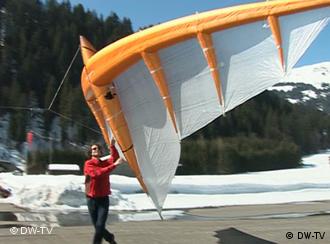I spent most of the summer of 1976 working on an inflatable hang glider for Jim Bede.
This was not the helium-filled wing. I saw pictures of it then, and there are pictures on the internet now, but I never saw that in person.
The wing I worked with was a low-pressure energy structure, in the sense that you could maintain the structure as long as you had battery for the fan to pressurize it. It was a very low pressure system, so leaks were not really an issue. Think of a bounce house in the form of a Marske plank wing as a hang glider, and you wouldn't be far off.
It used a rudder with lines to the swing seat to turn, something like a Quicksilver.
It was easy to set up in the hangar -- unroll it, attach the control bar and power up the fan.
In the field, on a training hill, with wind and rocks, it wasn't so simple. When partially inflated, it would try to beat itself to death on the rocks.
It weighed in at about 75 pounds, and would fit in the trunk of a passenger car, though it was probably a little bulkier than a paraglider because the cloth was a lot stiffer.
Unfortunately, there was a sink rate -- don't remember exact values, it was fairly high but in the realm of values I'd actually experienced in other hang gliders -- at which the fan couldn't maintain the differential pressure to keep the wings stiff. I imagined sinking, the structure getting floppy, increasing the sink rate, which would increase the floppiness... so I only ever flew it on a small hill.
But it was an interesting experience, overall.
My takeaway from that is that if the pressure is high enough that atmospheric pressure is a negligible variable, then sealing and leaks are a critical problem. If the pressure is low enough that leaks are not really a problem, then rapid descents become a problem.
===
Just to reiterate: that wasn't the wing I worked on. I saw pictures of it on the Newton airport runway, but I never saw that one myself.
It would have been either horrendously expensive to fly, or extremely slow to deflate, I think. How much helium to inflate? How long to compress it all back into a cylinder?
Still, I have to admit it solves the problem of collapsing paragliders pretty neatly.
One of my first thoughts on seeing paragliders collapsing lo those many years ago was a spar made of a Kevlar sock with a urethane liner. The idea was to keep it fairly small volume, so that it could be inflated to fairly high pressure with a CO2 cartridge. It would run tip to tip, so that while you might lose ram air pressurization and the normal airfoil shape, it would be less likely to wind up as a wad of fabric after encountering turbulence.
TjW,
Thanks for any and all your recall on your experiences in the Bede realm!
Fabric, pressure-keeping valves, over-pressure valves, pumps, porosities, ...worth continued explorations.
=================================================
James R. Bede
https://www.google.com/patents/US3944169 FILED: July 12, 1974
and
https://www.google.com/patents/US3400904
Wiki: https://en.wikipedia.org/wiki/Bede_Wing
=================================================
Bede:
See image at site: http://www.bd5.com/BDWing.JPG
Caption at site: "Now here's something most people haven't seen -- Jim Bede's Flying Wing. It is inflatable, and survives to this day. In fact, it was auctioned in mid-1998."
========================
Sept. 1975, Popular Science:
=================
 Home
Home







